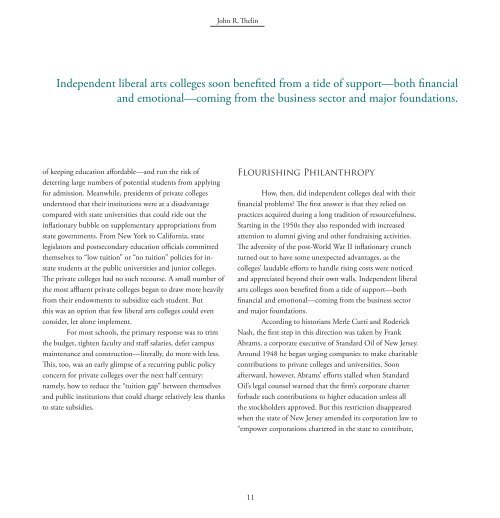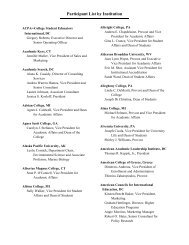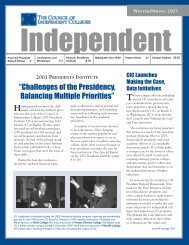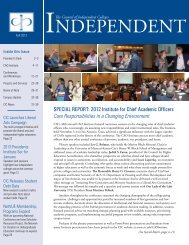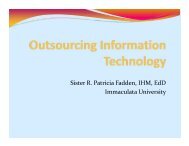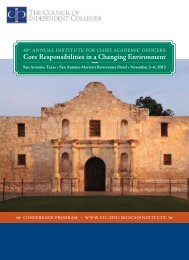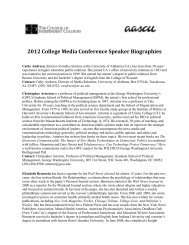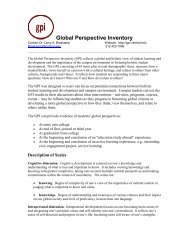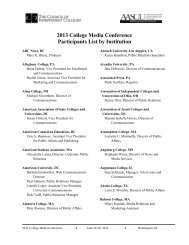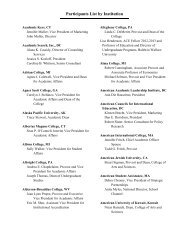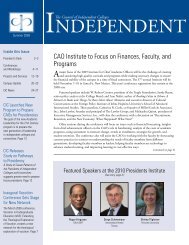Meeting the Challenge: - The Council of Independent Colleges
Meeting the Challenge: - The Council of Independent Colleges
Meeting the Challenge: - The Council of Independent Colleges
You also want an ePaper? Increase the reach of your titles
YUMPU automatically turns print PDFs into web optimized ePapers that Google loves.
John R. <strong>The</strong>lin<br />
<strong>Independent</strong> liberal arts colleges soon benefited from a tide <strong>of</strong> support—both financial<br />
and emotional—coming from <strong>the</strong> business sector and major foundations.<br />
<strong>of</strong> keeping education affordable—and run <strong>the</strong> risk <strong>of</strong><br />
deterring large numbers <strong>of</strong> potential students from applying<br />
for admission. Meanwhile, presidents <strong>of</strong> private colleges<br />
understood that <strong>the</strong>ir institutions were at a disadvantage<br />
compared with state universities that could ride out <strong>the</strong><br />
inflationary bubble on supplementary appropriations from<br />
state governments. From New York to California, state<br />
legislators and postsecondary education <strong>of</strong>ficials committed<br />
<strong>the</strong>mselves to “low tuition” or “no tuition” policies for instate<br />
students at <strong>the</strong> public universities and junior colleges.<br />
<strong>The</strong> private colleges had no such recourse. A small number <strong>of</strong><br />
<strong>the</strong> most affluent private colleges began to draw more heavily<br />
from <strong>the</strong>ir endowments to subsidize each student. But<br />
this was an option that few liberal arts colleges could even<br />
consider, let alone implement.<br />
For most schools, <strong>the</strong> primary response was to trim<br />
<strong>the</strong> budget, tighten faculty and staff salaries, defer campus<br />
maintenance and construction—literally, do more with less.<br />
This, too, was an early glimpse <strong>of</strong> a recurring public policy<br />
concern for private colleges over <strong>the</strong> next half century:<br />
namely, how to reduce <strong>the</strong> “tuition gap” between <strong>the</strong>mselves<br />
and public institutions that could charge relatively less thanks<br />
to state subsidies.<br />
Flourishing Philanthropy<br />
How, <strong>the</strong>n, did independent colleges deal with <strong>the</strong>ir<br />
financial problems <strong>The</strong> first answer is that <strong>the</strong>y relied on<br />
practices acquired during a long tradition <strong>of</strong> resourcefulness.<br />
Starting in <strong>the</strong> 1950s <strong>the</strong>y also responded with increased<br />
attention to alumni giving and o<strong>the</strong>r fundraising activities.<br />
<strong>The</strong> adversity <strong>of</strong> <strong>the</strong> post-World War II inflationary crunch<br />
turned out to have some unexpected advantages, as <strong>the</strong><br />
colleges’ laudable efforts to handle rising costs were noticed<br />
and appreciated beyond <strong>the</strong>ir own walls. <strong>Independent</strong> liberal<br />
arts colleges soon benefited from a tide <strong>of</strong> support—both<br />
financial and emotional—coming from <strong>the</strong> business sector<br />
and major foundations.<br />
According to historians Merle Curti and Roderick<br />
Nash, <strong>the</strong> first step in this direction was taken by Frank<br />
Abrams, a corporate executive <strong>of</strong> Standard Oil <strong>of</strong> New Jersey.<br />
Around 1948 he began urging companies to make charitable<br />
contributions to private colleges and universities. Soon<br />
afterward, however, Abrams’ efforts stalled when Standard<br />
Oil’s legal counsel warned that <strong>the</strong> firm’s corporate charter<br />
forbade such contributions to higher education unless all<br />
<strong>the</strong> stockholders approved. But this restriction disappeared<br />
when <strong>the</strong> state <strong>of</strong> New Jersey amended its corporation law to<br />
“empower corporations chartered in <strong>the</strong> state to contribute,<br />
11


